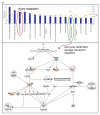Omics-based molecular target and biomarker identification
- PMID: 21370102
- PMCID: PMC3742302
- DOI: 10.1007/978-1-61779-027-0_26
Omics-based molecular target and biomarker identification
Abstract
Genomic, proteomic, and other omic-based approaches are now broadly used in biomedical research to facilitate the understanding of disease mechanisms and identification of molecular targets and biomarkers for therapeutic and diagnostic development. While the Omics technologies and bioinformatics tools for analyzing Omics data are rapidly advancing, the functional analysis and interpretation of the data remain challenging due to the inherent nature of the generally long workflows of Omics experiments. We adopt a strategy that emphasizes the use of curated knowledge resources coupled with expert-guided examination and interpretation of Omics data for the selection of potential molecular targets. We describe a downstream workflow and procedures for functional analysis that focus on biological pathways, from which molecular targets can be derived and proposed for experimental validation.
Figures







References
-
- Ransohoff DF. Cancer. Developing molecular biomarkers for cancer. Science. 2003;299:1679–80. - PubMed
-
- Riesterer O, Milas L, Ang KK. Use of molecular biomarkers for predicting the response to radiotherapy with or without chemotherapy. J Clin Oncol. 2007;25:4075–83. - PubMed
-
- Kim YS, Maruvada P, Milner JA. Metabolomics in biomarker discovery: future uses for cancer prevention. Future Oncol. 2008;4:93–102. - PubMed
-
- Hanash S. Integrated global profiling of cancer. Nat Rev Cancer. 2004;4:638–44. - PubMed
Publication types
MeSH terms
Substances
Grants and funding
LinkOut - more resources
Full Text Sources

